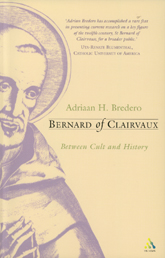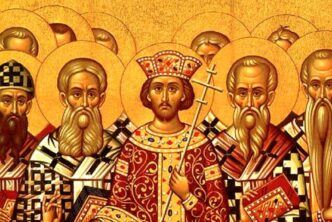To commemorate the feast day of Saint Bernard of Clairvaux, Doctor of the Church, enjoy this excerpt from Dr. Adriaan Bredero’s masterful study, Bernard of Clairvaux: Between Cult and History. Bredero’s personal story is fascinating: he began his career-long study of St. Bernard of Clairvaux as a college student, while hiding from the Nazis in 1944 Amsterdam. Here, Bredero re-evaluates many of the primary and secondary sources about St. Bernard, allowing a carefully considered historical portrait of the saint to emerge. Importantly, Bredero’s erudition raises enduring questions about the use of scholarly sources in history and hagiography.
 Bernard and the Historians
Bernard and the Historians
Through the centuries many historians have paid attention to St. Bernard, all with their own motives and from their own perspectives. As a result, this medieval abbot inevitably was characterized incidentally and evaluated by some in an almost inimitable way. More than once we find an emotional appreciation or disapproval of his actions. Thus developed—even outside of the hagiographic tradition—a number of historically questionable portraits of his person, which persisted for a shorter or longer period. Alexander Lenoire in 1814 provided a remarkable example of this phenomenon. This lodge member argued that Bernard’s unblemished life and compassion resulted from his intimate knowledge of the deepest secrets of freemasonry, which enabled him to draft the Rule of the Templars.
Obviously not all more or less cursory portraits of Bernard were as flattering as that of Lenoire. At times we find extremely negative judgments, based on just a few isolated passages from Bernard’s writings or from the vita prima. To these a commentary or interpretation would be added, with no attention to the context within which these passages were written or, rather, dictated.
It has been established that the frequent presupposition that Bernard was anti-intellectual is based on a remark with an ironic undertone made by Bernard around 1125 in a letter to Henry Murdach about Henry’s armchair learning. The fact that the addressee was completely addicted to his learning, and that this remark of Bernard’s was clearly relativized by William of Saint-Thierry in the A-redaction of the vita prima, is totally ignored. In redaction B this relativizing remark was eliminated. This suggests that this hagiographer intended to confirm this anti-intellectual image of Bernard; the more so, since none of the versions of this vita, which incorporated some passages from redaction A, pay any attention to William’s comments. They seem to be utterly unaware of its existence.
[…]A passage at the beginning of his treatise De consideratione, where Bernard deals with the meaning and the usefulness of “considering,” shows how ill-conceived it is to accuse him of anti-intellectualism. This is what he has to say:
First of all, “considering” purifies the source from which it springs, i.e., the spirit. It also regulates our emotions, gives direction to our actions, corrects deviations, builds our character, bestows honor and order to our lives; to put it in one word: it provides knowledge of divine and human things. It clarifies what is confused, unifies what is disjointed, collects what is dispersed, grasps what is hidden, searches for truth, and discovers what is treacherous and disguised. It foresees and organizes what must be done, checks what has been done, so that nothing remains in the spirit that has not been improved of needs no further improvement. In times of prosperity it foresees misfortune, and it hardly feels the latter when it has arrived. This last ability is called strength, the first one prudence.
There are other dubious portrayals of Bernard by historians, based on biased or incorrect interpretations of particular passages from his writings. Two of these have become rather widespread. The first of these, to which we already referred in the Introduction, concerns Bernard’s observations in his Apology with regard to the luxuriance of the abbey church that was being constructed in Cluny.
Read more by getting Bernard of Clairvaux: Between Cult and History today!





